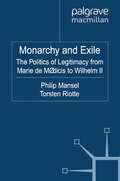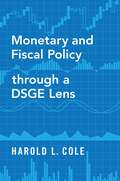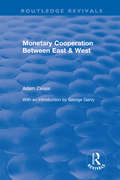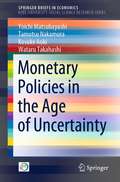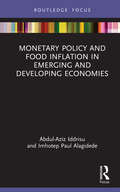- Table View
- List View
Monarchy and Exile: The Politics of Legitimacy from Marie de Médicis to Wilhelm II
by Philip Mansel and Torsten RiotteUsing detailed studies of fifteen exiled royal figures, the role of Exile in European Society and in the evolution of national cultures is examined. From the Jacobite court to the exiled Kings' of Hanover, the book provides an alternative history of monarchical power from the 16th to 20th century.
Monarchy and Modernity in Egypt: Politics, Islam and Neo-Colonialism Between the Wars (Library Of Middle East History Ser.)
by James WhiddenThe creation of the Egyptian monarchy in 1922, under King Fuad II, opened contests and debates over fundamental cultural questions, particularly definitions of Egyptian modernity, rule and identity. Here, James Whidden looks at the political, cultural and intellectual landscapes of Egypt between the wars, from the nationalist agitations for independence in 1919, the rise of the Wafd – first under Saad Zaghul and then Mustafa El-Nahas Pasha – and the rise and fall of different political and power brokers in the period, such as . Whidden therefore focuses on the different interpretations of the nature of Egyptian politics, highlighting the ways in which patriotism and elitism, Islam and tradition, colonial manipulations, and ideological politics combine. In particular, he examines how monarchists attempted to neutralise opponents through cultural works, patronage and political party contests. Monarchy and Modernity in Egypt is a vital resource for those interested in Middle East history, as well as intellectual developments within the region.
A Monarchy of Letters: Royal Correspondence and English Diplomacy in the Reign of Elizabeth I (Queenship and Power)
by Rayne AllinsonThis book examines Elizabeth's correspondence with several significant rulers, analyzing how her letters were constructed, drafted and presented, the rhetorical strategies used, and the role these letters played in facilitating diplomatic relations.
Monarchy, religion and the state: Civil religion in the United Kingdom, Canada, Australia and the Commonwealth
by Norman BonneyThis most thorough and contemporary examination of the religious features of the UK state and its monarchy argues that the long reign of Elizabeth has led to a widespread lack of awareness of the centuries old religious features of the state that are revealed at the accession and coronation of a new monarch. It is suggested that the next succession to the throne will require major national debates in each realm of the monarch to judge whether the traditional rituals which require professions of Christianity and Protestantism by the new monarch are appropriate, or whether they might be replaced by alternative secular or interfaith ceremonies.It will be required reading for those who study the government and politics of the UK, Canada, Australia and the other 13 realms of the monarch. It will also appeal to as well as students and lecturers in history, sociology and religious studies and citizens interested in the monarchy and contemporary religious issues.
Monarchy, religion and the state: Civil religion in the United Kingdom, Canada, Australia and the Commonwealth
by Norman BonneyThis most thorough and contemporary examination of the religious features of the UK state and its monarchy argues that the long reign of Elizabeth has led to a widespread lack of awareness of the centuries old religious features of the state that are revealed at the accession and coronation of a new monarch. It is suggested that the next succession to the throne will require major national debates in each realm of the monarch to judge whether the traditional rituals which require professions of Christianity and Protestantism by the new monarch are appropriate, or whether they might be replaced by alternative secular or interfaith ceremonies.It will be required reading for those who study the government and politics of the UK, Canada, Australia and the other 13 realms of the monarch. It will also appeal to as well as students and lecturers in history, sociology and religious studies and citizens interested in the monarchy and contemporary religious issues.
MONET & FISCAL POLICY THR A DSGE LENS C
by Harold L. ColeIn Monetary and Fiscal Policy Through a DSGE Lens, Harold L. Cole develops and extends versions of a classic quantitative model of economic growth to take on a wide range of topics in monetary and fiscal policy. Bridging the gap between current undergraduate and graduate texts in the field, this comprehensive book covers the basic elements of advanced macroeconomics and equips readers to understand the debate on key policy questions. By using the simple DSGE, or dynamic stochastic general equilibrium, framework to build a series of quantitative models, the book combines a gradual introduction to advanced analytic methods with computer programming and quantitative policy analysis. In a clear discussion of the sophisticated interaction between theory and data, Cole explains how to gauge how well a model captures key elements in the data and how to reverse engineer a model to data. The book covers costs of inflation, optimal monetary policy, the impact of labor and capital taxes, and optimal fiscal policy. It systematically discusses technical material including the new Keynesian liquidity shock models, standard analytic methods, such as Lagrangian methods, and computational methods using Matlab and Python. With a strong computational emphasis, the volume teaches how to program up and solve systems of non-linear equations and develop models to study the macroeconomy. Knowing how to deeply understand and analyze models and develop computational code to evaluate the implications of those models is essential for students of macroeconomics. This book connects the standard undergraduate material to the elaborate models of advanced graduate courses with systematic and logical coverage of the basics of advanced modern macroeconomics.
Monetary Analysis at Central Banks
by David CobhamWhatever happened to the money supply? This book explains how the analysis of monetary and credit aggregates is undertaken at the Bank of England, the European Central Bank and (as an example of a developing country) the Bank of Tanzania. The book also explores how this analysis relates to these central banks' monetary policy strategies and how it feeds into policymaking. An editorial introduction provides the intellectual and historical background – from the contributions of key economists such as Milton Friedman and Jacques Polak, to monetary targeting and inflation targeting – and argues that central banks and policy analysts would be foolish to neglect the insights monetary analysis can offer. The papers compiled in Monetary Analysis at Central Banks demonstrate just how useful and varied those insights are.
Monetary and Financial Policy in the Euro Area: An Introduction (Springer Texts in Business and Economics)
by Maximilian FandlThis textbook provides a comprehensive overview of monetary policy, banking supervision and financial stability in the euro area. The author uses his professional experience in central banking to provide a thorough understanding of European economics and to explore how the monetary and financial system functions. The book takes into account the profound changes that resulted from crisis developments in recent years, such as the implementation of quantitative easing or the establishment of the Single Supervisory Mechanism (SSM). The author also invites readers to develop their thoughts on alternative policies to shape the monetary and financial system of the future. The textbook is tailor-made for intermediate courses in economics but will also appeal to those preparing a career in central banking or financial regulation.
A Monetary and Fiscal History of the United States, 1961–2021
by Alan S. BlinderFrom the New York Times bestselling author, the fascinating story of U.S. economic policy from Kennedy to Biden—filled with lessons for todayIn this book, Alan Blinder, one of the world’s most influential economists and one of the field’s best writers, draws on his deep firsthand experience to provide an authoritative account of sixty years of monetary and fiscal policy in the United States. Spanning twelve presidents, from John F. Kennedy to Joe Biden, and eight Federal Reserve chairs, from William McChesney Martin to Jerome Powell, this is an insider’s story of macroeconomic policy that hasn’t been told before—one that is a pleasure to read, and as interesting as it is important.Focusing on the most significant developments and long-term changes, Blinder traces the highs and lows of monetary and fiscal policy, which have by turns cooperated and clashed through many recessions and several long booms over the past six decades. From the fiscal policy of Kennedy’s New Frontier to Biden’s responses to the pandemic, the book takes readers through the stagflation of the 1970s, the conquest of inflation under Jimmy Carter and Paul Volcker, the rise of Reaganomics, and the bubbles of the 2000s before bringing the story up through recent events—including the financial crisis, the Great Recession, and monetary policy during COVID-19.A lively and concise narrative that is sure to become a classic, A Monetary and Fiscal History of the United States, 1961–2021 is filled with vital lessons for anyone who wants to better understand where the economy has been—and where it might be headed.
Monetary and Fiscal Policy through a DSGE Lens
by Harold L. ColeIn Monetary and Fiscal Policy Through a DSGE Lens, Harold L. Cole develops and extends versions of a classic quantitative model of economic growth to take on a wide range of topics in monetary and fiscal policy. Bridging the gap between current undergraduate and graduate texts in the field, this comprehensive book covers the basic elements of advanced macroeconomics and equips readers to understand the debate on key policy questions. By using the simple DSGE, or dynamic stochastic general equilibrium, framework to build a series of quantitative models, the book combines a gradual introduction to advanced analytic methods with computer programming and quantitative policy analysis. In a clear discussion of the sophisticated interaction between theory and data, Cole explains how to gauge how well a model captures key elements in the data and how to reverse engineer a model to data. The book covers costs of inflation, optimal monetary policy, the impact of labor and capital taxes, and optimal fiscal policy. It systematically discusses technical material including the new Keynesian liquidity shock models, standard analytic methods, such as Lagrangian methods, and computational methods using Matlab and Python. With a strong computational emphasis, the volume teaches how to program up and solve systems of non-linear equations and develop models to study the macroeconomy. Knowing how to deeply understand and analyze models and develop computational code to evaluate the implications of those models is essential for students of macroeconomics. This book connects the standard undergraduate material to the elaborate models of advanced graduate courses with systematic and logical coverage of the basics of advanced modern macroeconomics.
Monetary and Fiscal Strategies in the World Economy
by Michael CarlbergThis book studies the strategic interactions between monetary and fiscal policies in the world economy. The world economy consists of two regions, say Europe and America. The policy makers are the central banks and the governments. The policy targets are low inflation, low unemployment, and low structural deficits. There are demand shocks, supply shocks, and mixed shocks. There are regional shocks and common shocks. This book develops a series of basic, intermediate, and more advanced models. Here the focus is on the Nash equilibrium. The key questions are: Given a shock, can policy interactions reduce the existing loss? And to what extent can they do so? Another topical issue is policy cooperation. To illustrate all of this there are a lot of numerical examples. The present book is part of a larger research project on European Monetary Union, see the references given at the back of the book. Some parts of this project were presented at the World Congress of the International Economic Association, at the International Conference on Macroeconomic Analysis, at the International Institute of Public Finance, and at the International Atlantic Economic Conference. Other parts were presented at the Macro Study Group of the German Economic Association, at the Annual Meeting of the Austrian Economic Association, at the Göttingen Workshop on International Economics, at the Halle Workshop on Monetary Economics, at the Research Seminar on Macroeconomics in Freiburg, at the Research Seminar on Economics in Kassel, and at the Passau Workshop on International Economics.
Monetary Cooperation Between East and West (Routledge Revivals)
by Adam ZwassThe fifth volume of the [Institute] series "Comparative Studies in Economics and Economic Systems" treats the problems of monetary relations between East and West. The author, Dr. Adam Zwass brings his extensive knowledge of monetary relations in Eastern Europe, gained while he held a number of posts in Poland and during his association with the CMEA Secretariat in Moscow. It was not the author's intention to draw up a m aster plan for closer cooperation between the two monetary systems, which differ widely in many respects. His main concern is the Eastern monetary system, and its instruments, institutions, and functions are subjected to a thorough analysis. Problems are pinpointed and suggestions made for improvements. Finally, Dr. Zwass considers the prospects for the development of a worldwide currency system. It is hoped that his book will stimulate further research that would pave the way for productive cooperation between East and West in monetary relations.This title was first published in 1975.
Monetary Cooperation Between East and West (Routledge Revivals)
by Adam ZwassThe fifth volume of the [Institute] series "Comparative Studies in Economics and Economic Systems" treats the problems of monetary relations between East and West. The author, Dr. Adam Zwass brings his extensive knowledge of monetary relations in Eastern Europe, gained while he held a number of posts in Poland and during his association with the CMEA Secretariat in Moscow. It was not the author's intention to draw up a m aster plan for closer cooperation between the two monetary systems, which differ widely in many respects. His main concern is the Eastern monetary system, and its instruments, institutions, and functions are subjected to a thorough analysis. Problems are pinpointed and suggestions made for improvements. Finally, Dr. Zwass considers the prospects for the development of a worldwide currency system. It is hoped that his book will stimulate further research that would pave the way for productive cooperation between East and West in monetary relations.This title was first published in 1975.
Monetary Divergence: Domestic Policy Autonomy in the Post-Bretton Woods Era (Michigan Studies In International Political Economy)
by David Bearce"In a meticulously researched study, David Bearce demonstrates that, contrary to predictions, financial globalization has not resulted in a systematic convergence of national monetary policies. The book is a must-read for students of the political economy of international finance. Highlighting the critical role of partisan politics in determining policy outcomes, Bearce adds a new and important dimension to our understanding of the impacts of international capital mobility in the contemporary era." —Benjamin Jerry Cohen, University of California, Santa Barbara "Bearce offers a compelling analysis of partisan economic policy in an open economy. By analyzing both fiscal and monetary policies, Bearce extends our understanding of how the electoral imperative conditions policy behavior. His conclusions will have to be addressed in any future debate about the topic." —William Bernhard, University of Illinois at Urbana-Champaign "Interest group divisions over exchange rates and macroeconomic policy have been at the center of international political economy research for about 20 years. Political scientists have studied these cleavages, focusing on the policy interests of various industry groups. On a separate but parallel track, another group of researchers explored the relationship between partisan politics and macroeconomic policy choices. In this exceptionally well researched book, Bearce integrates these two analytical traditions. Noting that industry groups are typically important organized constituents in left-wing and right-wing political parties, Bearce demonstrates how macroeconomic policy outcomes in advanced countries vary systematically with the alternation of political parties in government." —J. Lawrence Broz, University of California, San Diego David H. Bearce is Assistant Professor of Political Science at the University of Pittsburgh.
Monetary Integration in Europe (Studies in Economic Transition)
by H. TomannCan the European Economic and Monetary Union survive as an institution providing the highest degree of monetary integration? Can it withstand crises in international markets and contribute to the stability of the global financial system? This book addresses these questions, emphasising the need for new forms of economic policy coordination.
Monetary Integration in Europe: The European Monetary Union after the Financial Crisis (Studies in Economic Transition)
by Horst TomannThis book provides a fully revised and up-to-date analysis of the Economic and Monetary Union (EMU). With four entirely new chapters on responses to the financial crisis and the debate on reform options, Tomann assesses the EMU in comparison with other currency regimes through the adoption of a historical analysis. The book discusses in detail basic issues with currency and comprehensively analyzes monetary policy, highlighting problems of policy coordination. Tomann explores new monetary institutions that have been established in response to the financial crisis, before addressing long-term issues and reviewing reform proposals. By focusing on monetary issues the book offers a better understanding of macroeconomic policies and international policy cooperation, and, by extension, provides a thorough economic assessment of the EMU as an institution as it stands today.
Monetary Integration in the European Union (The European Union Series)
by Michele ChangThe euro has been a remarkable success. By its tenth anniversary in 2009 it had become one of the world's major currencies, rivalled only by the US dollar in usage and global influence. It is used by 320 million people in 16 countries, and these figures look set to rise as, with the exception of Britain and Denmark, all EU member states are obliged to adopt the currency.This major new text provides a theoretically-informed account of Economic and Monetary Union in the EU. It examines the history of European monetary integration, from its origins in the Bretton Woods Agreements through to the adoption of the euro by the accession states of Central and Eastern Europe. It provides a clear explanation of the key policies and institutions of economic integration and examines the role played by the euro in international markets. While it is informed throughout by the latest research in economics and political science, the book's technical discussion has been kept to a minimum to help make it an extremely readable introduction to European monetary integration.
Monetary Policies in the Age of Uncertainty (SpringerBriefs in Economics)
by Yoichi Matsubayashi Tamotsu Nakamura Kosuke Aoki Wataru TakahashiThis book provides an interesting review of Japanese monetary policies after the bubble economy. The Bank of Japan was the first central bank in advanced economies to implement the unconventional monetary policies during the period. After the Lehman shock, most advanced economies also carried out similar monetary policies to boost their own economies. The Japanese experience in the 1990s and 2000s no doubt played a key role during the period. Although various aspects of the experiences have been examined, not many books have been published based on intensive discussions between the macro and monetary theorists who have been active in academics and the practitioners who have actually been involved in monetary policy. This small but important book has focused on the Japanese experience. Evaluation of that experience found that three solid pillars are of crucial importance: theory, institution, and experience. Those form the basis of the book, without theory, no policies will be formulated and implemented, and implementation depends crucially on institution. Chapter 1 provides a clear theoretical background for the unconventional monetary policies and inflation targeting. Chapter 2 intensively explores the meaning and desirability of the independence of central banks. Chapter 3 reviews the consequences of the Japanese monetary policies in recent decades in comparison with those in other advanced economies.
Monetary Policy (National Bureau of Economic Research Studies in Business Cycles #29)
by N. Gregory MankiwIn Monetary Policy, leading monetary economists discuss applied aspects of monetary policy and offer practical new research on the timing, magnitude, and channels of central banking actions. Some of the papers in this volume evaluate a variety of policy rules based on monetary aggregates, nominal income, commodity prices, and other economic variables. Others analyze price behavior and inflation, particularly the short-run behavior of prices. Still others examine the monetary transmission mechanism—the channel through which the central bank's actions affect spending on goods and services—with a special focus on the reduction in bank lending that must accompany a reduction in reserves. This new research will be of special interest to central bankers and academic economists.
Monetary Policy (National Bureau of Economic Research Studies in Business Cycles #29)
by N. Gregory MankiwIn Monetary Policy, leading monetary economists discuss applied aspects of monetary policy and offer practical new research on the timing, magnitude, and channels of central banking actions. Some of the papers in this volume evaluate a variety of policy rules based on monetary aggregates, nominal income, commodity prices, and other economic variables. Others analyze price behavior and inflation, particularly the short-run behavior of prices. Still others examine the monetary transmission mechanism—the channel through which the central bank's actions affect spending on goods and services—with a special focus on the reduction in bank lending that must accompany a reduction in reserves. This new research will be of special interest to central bankers and academic economists.
Monetary Policy and Financial Repression in Britain, 1951 - 59 (Palgrave Studies in Economic History)
by W. AllenBritish monetary policy was reactivated in 1951 when short-term interest rates were increased for the first time in two decades. The book explores the politics of formulating monetary policy in the 1950s and the techniques of implementing it, and discusses the parallels between the present monetary situation and that of 1951.
Monetary Policy and Food Inflation in Emerging and Developing Economies (Routledge Focus on Environment and Sustainability)
by Abdul-Aziz Iddrisu Imhotep Paul AlagidedeThis book focuses on the impact of monetary policy and food price volatility and inflation in emerging and developing economies. The tendency for food price volatility to blot inflation forecasting accuracy, engender tail dynamics in the overall inflation trajectory and derail economic welfare is well known in the literature. The ability of monetary policy to exact stability in food prices, theoretically, has also been well espoused. The empirical evidence, however, is not only in short supply, but also the studies available have dwelt on approaches that underplay the volatile behaviour of food prices. This book focuses on inflation targeting in emerging economies such as Chile, Mexico, Turkey, Brazil, Hungary, Russia, Colombia, South Africa, Indonesia and Ghana, as these are economies with considerable proportion of the consumption basket occupied by food. The book provides the means to understand at first hand the correct way to model food inflation, account for the related policy responses to deviations either in the short or medium to long term, and in market conditions that are subject to excessive variability. Strong evidence is presented that captures deviations of food prices from their trend and the accompanying monetary policy effect in stabilizing such variabilities across distinct frequencies. The novel approach in this book addresses the burgeoning puzzles of asymmetry in monetary policy effect on food prices at high, medium and low episodes of food inflation. In doing so, this book presents a powerful tool for researchers interested in understanding not just the transmission mechanism, but also the magnitudes involved, and to policymakers whose existing tools have failed them. Future studies will do well to deepen the evidence and seek new grounds to which the phenomenon manifests beyond and below emerging markets. This book will be of great interest to students, scholars and policymakers involved in agricultural economics, financial economics, food security and sustainable development.
Monetary Policy and Food Inflation in Emerging and Developing Economies (Routledge Focus on Environment and Sustainability)
by Abdul-Aziz Iddrisu Imhotep Paul AlagidedeThis book focuses on the impact of monetary policy and food price volatility and inflation in emerging and developing economies. The tendency for food price volatility to blot inflation forecasting accuracy, engender tail dynamics in the overall inflation trajectory and derail economic welfare is well known in the literature. The ability of monetary policy to exact stability in food prices, theoretically, has also been well espoused. The empirical evidence, however, is not only in short supply, but also the studies available have dwelt on approaches that underplay the volatile behaviour of food prices. This book focuses on inflation targeting in emerging economies such as Chile, Mexico, Turkey, Brazil, Hungary, Russia, Colombia, South Africa, Indonesia and Ghana, as these are economies with considerable proportion of the consumption basket occupied by food. The book provides the means to understand at first hand the correct way to model food inflation, account for the related policy responses to deviations either in the short or medium to long term, and in market conditions that are subject to excessive variability. Strong evidence is presented that captures deviations of food prices from their trend and the accompanying monetary policy effect in stabilizing such variabilities across distinct frequencies. The novel approach in this book addresses the burgeoning puzzles of asymmetry in monetary policy effect on food prices at high, medium and low episodes of food inflation. In doing so, this book presents a powerful tool for researchers interested in understanding not just the transmission mechanism, but also the magnitudes involved, and to policymakers whose existing tools have failed them. Future studies will do well to deepen the evidence and seek new grounds to which the phenomenon manifests beyond and below emerging markets. This book will be of great interest to students, scholars and policymakers involved in agricultural economics, financial economics, food security and sustainable development.
Monetary Policy and the Onset of the Great Depression: The Myth of Benjamin Strong as Decisive Leader
by M. TomaMonetary Policy and the Onset of the Great Depression challenges Milton Friedman and Anna Schwartz's now consensus view that the high tide of the Federal Reserve System in the 1920s was due to the leadership skills of Benjamin Strong, head of the Federal Reserve Bank of New York.
Monetary Policy, Financial Crises, and the Macroeconomy: Festschrift for Gerhard Illing
by Frank Heinemann Ulrich Klüh Sebastian WatzkaThis volume investigates different aspects of monetary policy and prevention of financial crises. It discusses some recently suggested measures for central banks' responses to liquidity shortages and to the liquidity trap, methods for assessing the potential of crisis contagion via the interbank network, and the interaction between micro- and macro-prudential regulation. It compares different approaches for solving the Eurozone sovereign-debt problem and provides a new and intriguing explanation for rising income inequality. The authors are experts on monetary policy, financial crises, and contract theory from different European universities and central banks.
